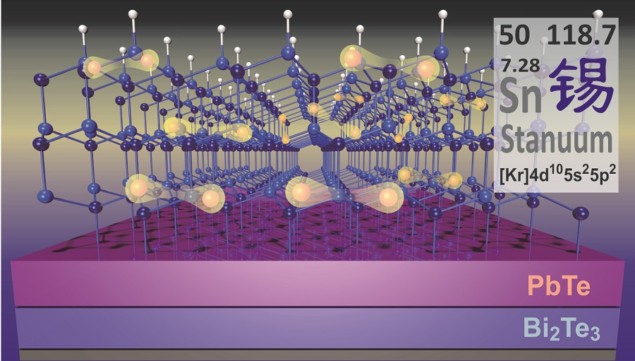
Superconductivity – when a material has zero electrical resistance, therefore zero energy loss, at low temperatures – has enormous potential for energy-efficient electronic devices. A research team in Beijing has now changed thin tin films from insulating to superconducting by tuning the thickness, introducing a level of versatility that could revolutionize the production of microelectronic circuits.
Observations of superconductivity in 2–20 atomic layers of “grey” tin , came as a surprise even to Qi-Kun Xue – whose expertise is focused on this area of research – as well as his team at Tsinghua University, Beijing. Tin occurs in two crystallographic forms in nature – white and grey – and previously only white tin had shown superconducting properties. Single-layer and bulk grey tin remain non-superconducting, so Xue and colleagues found they were able to tune grey tin’s properties from an insulating monolayer to superconducting in a few layers through substrate engineering.
A potential application of the discovery is building highly efficient microchips from a single material. The superconducting wires made of multilayers can be separated by regions of insulating monolayers on the surface of a microchip. Using a single material has advantages for production, and can also improve reliability by reducing interfaces.
In addition, the researchers discovered that the thickness of the lead-tellurium alloy on which the tin layer was grown changed the temperature at which the tin film became superconducting. This allows for extra control over the superconducting state.

Tin pest has its advantages
Grey α-tin is arranged the same way as the carbon-based diamond, while white β-tin has a crystal structure like most other metals. Below 13 °C, white tin slowly transforms to grey tin. “This caused some notorious troubles in the past and the process is termed as tin pest or tin disease,” says Ding Zhang, corresponding author. “What we found is that the grey tin can be scientifically quite interesting.”
Although not observed by Xue, Zhang and colleagues, monolayers of grey tin – called stanene from the Latin name for tin – are also predicted to carry dissipationless spin-polarized current, bringing extreme energy efficiency to new types of digital magnetic memory. Stanene films do not require any protection layer on top because it is resistant to oxidation. Grey tin could also be an ideal system to study interactions between spin-polarized currents and superconductors.
Their next steps are to gain more understanding of the superconducting stanene before investigating applications.
Full details are reported in Nature Physics.



